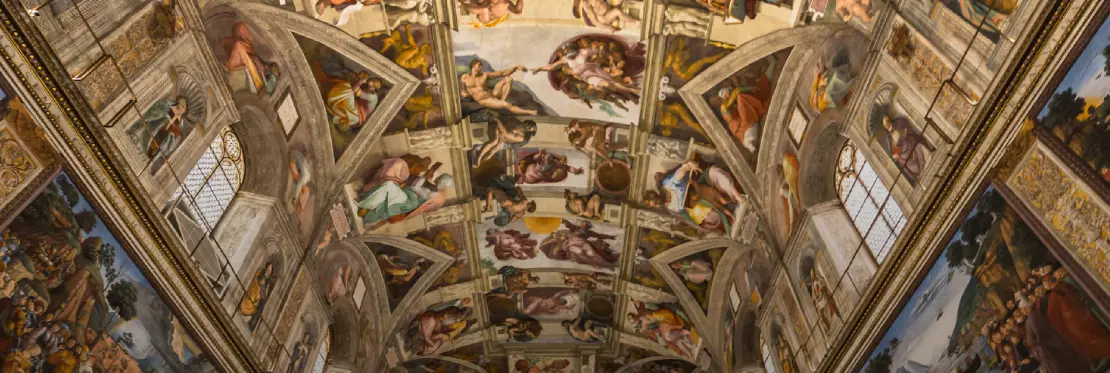
What do the frescoes of the Sistine Chapel mean?
German writer Goethe once wrote: “Without having seen the Sistine Chapel, one cannot form an appreciable idea of what mankind is capable of achieving.” And how right he was. This room, one of the most famous artistic spaces in the world, is a sublime aesthetic experience and a highlight of any tour of the Vatican Museums.
It is impossible to think of the Sistine Chapel without considering Michelangelo Buonarroti. He himself said, “Perfection is no small thing, but it is made of small things”—a perfection he pursued in his masterpiece through his various frescoes. Read on to learn more about the artworks that cover the Sistine Chapel.
The Frescoes of the Sistine Chapel
The ceiling of the Sistine Chapel was painted solely by Michelangelo at the request of Pope Julius II between 1508 and 1512. Due to the challenging surface and the fact that the artist worked alone, creating these frescoes is considered an impressive artistic feat in itself.
The ceiling is divided into nine panels that depict scenes from the Book of Genesis, representing the story of the creation of the world according to the Catholic Church.
The different panels are dedicated to:
- The separation of light and darkness
- The creation of the Sun, the Moon, and the planets
- The separation of land and sea
- The creation of Adam
- The creation of Eve (central panel)
- The expulsion from paradise
- The sacrifice of Noah
- The Great Flood
- The drunkenness of Noah
These panels are accompanied by figures of prophets (Zechariah, Joel, Isaiah, Ezekiel, Daniel, Jeremiah, and Jonah) and sibyls (Delphic, Erythraean, Cumaean, Persian, and Libyan), creating a blend of Christian and pagan elements. This unique characteristic adds another layer of interest to Michelangelo's work, which you can admire with your tickets to the Sistine Chapel.
As if that weren’t enough, the four corners of the ceiling depict stories of Israel's salvation, completing a work as beautiful as it is complex, one that deserves a significant amount of time during a tour of the Vatican Museums to fully appreciate.
The most important work of the Vatican Museums
Among all the sections that make up the ceiling of the Sistine Chapel, The Creation of Adam stands out as one of the most widely recognized artistic images worldwide, which makes it worth buying tickets for the Vatican Museums and the Sistine Chapel.. In this scene, we see Adam reclining languidly on the left and the figure of God on the right.
Although it appears to be a symmetrical fresco at first glance, upon analyzing the positions and gestures of both figures, it becomes evident that this is not the case. This demonstrates that Michelangelo was not only a magnificent sculptor but also knew how to capture figures and their movement on a flat surface.
Another interesting feature of this fresco is that it also includes the figure of Eve in the background, beneath God's arm, protected and waiting for her turn to be created.
Due to the fresco’s size and the height that separates the floor from the ceiling, it can be challenging to identify all the details. For this reason, we recommend taking a guided tour of the Vatican Museums with a specialized guide. Explore our options and reserve your spot today.